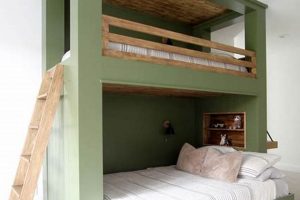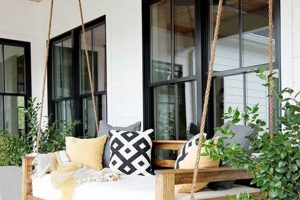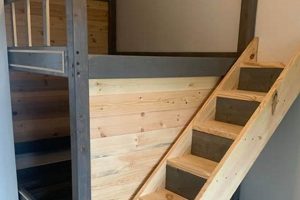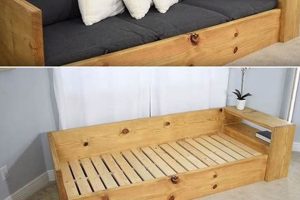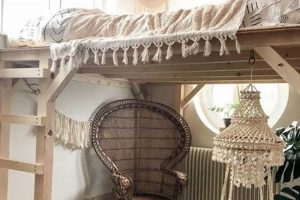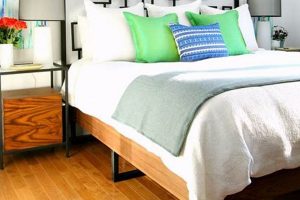The concept involves constructing a sleeping space for a young child, typically between the ages of one and three, using materials and designs selected and assembled by individuals rather than purchasing a pre-fabricated product. A typical example would be adapting an existing crib frame or utilizing lumber to create a low-to-the-ground bed frame, ensuring easy access for the child.
Constructing a sleeping space independently offers several advantages. These include potential cost savings, customization options to fit specific room dimensions or aesthetic preferences, and the satisfaction of a personally completed project. Historically, creating furniture for children at home was commonplace due to economic necessity and the limited availability of mass-produced goods. This approach allows for the selection of non-toxic materials and the implementation of safety features tailored to the child’s specific needs.
The subsequent sections will delve into various design considerations, material selections, and safety precautions essential for the successful creation of an appropriate and secure sleeping environment. Further topics will encompass step-by-step construction guides and innovative approaches to personalizing the finished product.
Essential Considerations for Independent Construction of a Child’s Sleeping Space
The following recommendations address crucial aspects to ensure a safe, functional, and aesthetically appropriate sleeping environment tailored for a young child when undertaking independent construction.
Tip 1: Prioritize Safety Standards: Adhere to established safety guidelines for crib construction, even if not building a traditional crib. Maintain proper slat spacing to prevent entrapment and utilize non-toxic finishes and materials. Regularly inspect the structure for any signs of weakness or damage.
Tip 2: Optimize Low-to-the-Ground Design: A low profile minimizes potential injury from falls. The height of the sleeping surface should facilitate easy independent access for the child.
Tip 3: Choose Durable and Child-Safe Materials: Opt for solid wood or high-quality plywood. Avoid materials containing lead, phthalates, or other hazardous substances. Securely fasten all components to prevent detachment.
Tip 4: Employ Rounded Edges and Smooth Surfaces: Eliminate sharp edges and corners that could pose a safety risk. Sand all surfaces thoroughly to prevent splinters and ensure a smooth, touch-friendly finish.
Tip 5: Ensure Proper Ventilation: Design the structure to allow adequate airflow around the mattress. This helps prevent moisture buildup and reduces the risk of mold growth.
Tip 6: Consider Future Growth: While designing for a toddler, contemplate the possibility of extending the sleeping space to accommodate the child’s future growth. Modular designs or easily adaptable frames can provide long-term utility.
Tip 7: Implement Secure Fastening Systems: Use screws and bolts instead of nails or staples for enhanced structural integrity. Counter-sink screw heads and cover them with plugs or wood filler to prevent injury.
Adhering to these recommendations promotes the creation of a sleeping space that is both safe and conducive to a child’s development and well-being. Prioritizing safety and functionality, while thoughtfully considering the childs specific needs, is paramount.
The subsequent sections will explore further customization options and advanced building techniques for those seeking to enhance the functionality and aesthetic appeal of the finished product.
1. Safety
Safety forms a foundational pillar in the independent construction of a toddler’s sleeping space. Compromising safety elements can lead to adverse outcomes, ranging from minor injuries to severe accidents. For instance, inadequate slat spacing presents a potential entrapment hazard, while unstable structures could collapse. The use of non-toxic materials is a non-negotiable aspect of safety, safeguarding against potential chemical exposure and allergic reactions. Real-life examples underscore the importance of this connection; improperly sanded surfaces can cause splinters, and sharp edges can cause cuts, highlighting the practical significance of prioritizing safety during all phases of construction.
Effective implementation of safety protocols includes rigorous adherence to established guidelines and regulations for crib and bed construction. For instance, ensuring proper fastening techniques to stabilize the frame. This is further complemented by the careful selection of materials certified as child-safe and free from harmful substances. Regular inspections of the structure are essential for early detection of potential hazards, such as loose screws or structural weakness. This proactive approach mitigates the risk of accidents and ensures the continued safety of the sleeping environment.
In conclusion, safety constitutes an indispensable component in the independent construction of a toddler’s sleeping space. The potential consequences of neglecting safety protocols underscore the critical importance of diligent planning, careful execution, and continuous monitoring. Overcoming safety challenges demands a comprehensive understanding of potential hazards and a steadfast commitment to implementing preventative measures, thereby ensuring a secure sleeping environment for the child.
2. Materials
Material selection is a critical determinant of the structural integrity, safety, and overall longevity of a independently constructed sleeping space for a toddler. The correlation between material choice and the resulting product is direct; for example, using untreated softwood can lead to structural weakness and susceptibility to damage, whereas selecting formaldehyde-free plywood minimizes exposure to potentially harmful volatile organic compounds. Real-life examples frequently demonstrate the impact of this connection, from beds constructed with unstable materials collapsing under minimal weight to instances where children have experienced allergic reactions to treated wood.
Further analysis reveals practical applications for informed material selection. Solid hardwoods, such as maple or oak, offer superior durability and resistance to wear, making them suitable for load-bearing components. Non-toxic paints, stains, and sealants are essential for preventing chemical exposure through inhalation or ingestion. Careful consideration of fasteners, such as screws and bolts, ensures secure connections and prevents structural failure. The integration of recycled materials, where appropriate and structurally sound, can contribute to sustainability efforts. These applications demonstrate the direct effect materials have on building a bed structure.
In conclusion, the choice of materials has broad implications for every aspect of the bed. The challenges associated with material selection require a deep understanding of various materials. A sustained commitment to using safe and durable materials remains necessary to ensure that the space is both structurally sound and conducive to the health and well-being of the child. Therefore, the structural and functional outcome of the space is dependent on the materials chosen.
3. Design
The design phase is a foundational element in the independently constructed toddler sleeping space, dictating not only the aesthetic presentation but, more importantly, the functional utility and safety characteristics. The intended design directly influences material selection, construction methods, and the overall suitability of the structure for its intended user.
- Structural Integrity and Stability
The structural design directly impacts the bed’s ability to withstand the dynamic forces exerted by a toddler. Designs prioritizing joint strength and material resilience are essential. An example would be mortise and tenon joints versus simple butt joints in the frame construction, significantly enhancing stability. Failures in this aspect can lead to structural collapse, posing a significant safety hazard. The implication here is that robust designs and material choices are required to ensure long-term stability.
- Ergonomics and Accessibility
Ergonomic considerations dictate the ease of access for the toddler. A low-profile design facilitates independent entry and exit, reducing the risk of falls. For example, beds with a rail height of no more than a few inches above the mattress surface are considered ergonomically appropriate. Design flaws in this area can lead to difficulty getting in and out of bed, potentially discouraging independent sleep habits. The implication is that design should prioritize child-friendly accessibility.
- Safety Features Integration
Design choices significantly affect the integration of safety features. Rounded edges, smooth surfaces, and secure fastening systems are crucial elements. For instance, recessed screw heads and the absence of sharp corners mitigate potential injury risks. Neglecting these considerations can result in preventable accidents. The implication is that safety features must be intrinsically integrated into the design phase rather than applied as afterthoughts.
- Aesthetic and Functional Customization
The design allows for customization to suit specific needs and preferences. Integrating storage solutions, such as drawers underneath the sleeping platform, can enhance functionality. Aesthetic choices, such as paint color and decorative elements, can create a stimulating and comfortable sleeping environment. Poor design in this realm may lead to missed opportunities for functional enhancement and personalization. The implication is that the design phase should consider both functional and aesthetic customization opportunities.
These design facets collectively illustrate the interconnectedness of aesthetics, functionality, and safety. Effective design involves a holistic approach that integrates these considerations to create a sleeping space that is both developmentally appropriate and conducive to the child’s well-being. By thoughtfully considering these aspects, the independent constructor can ensure a higher-quality, safer, and more functional end product.
4. Dimensions
The dimensions of a independently constructed toddler sleeping space are critical to safety, functionality, and the child’s developmental appropriateness. Inadequate dimensions can lead to safety hazards, discomfort, or impede the child’s independent use of the bed. For example, a sleeping surface that is too high poses a fall risk, while one that is too narrow restricts movement and comfort. The connection between the physical dimensions and the child’s well-being is a primary consideration in any independent construction effort. Improper height and length of the bed can potentially injure a child.
Practical applications of dimensional considerations include adhering to established guidelines for toddler bed sizes. Standard toddler mattresses typically measure around 28 inches wide by 52 inches long. The bed frame should be constructed to accommodate this mattress size snugly, preventing gaps that could pose entrapment hazards. The height of the bed should be low to the ground, often no more than a few inches above the mattress, to facilitate easy access. Railings, if incorporated, should be of sufficient height to prevent falls but low enough to allow the child to climb in and out independently. An appropriate sleeping space of certain dimensions for a child, allows children to be safe and comfortably in bed.
Therefore, the specific dimensional considerations depend on multiple requirements. Overcoming the challenges associated with dimensional planning requires a thorough understanding of child development, safety regulations, and the physical limitations of the intended space. A commitment to precise measurements and careful execution will ensure a space that is both safe and conducive to the child’s healthy development. Ensuring that the correct dimensions are used, help avoid and prevent injuries to children.
5. Stability
The structural integrity of a independently constructed toddler sleeping space directly determines its safety and longevity. Inadequate stability poses a significant risk of collapse, leading to potential injuries. Cause-and-effect relationships are readily apparent; for example, insufficient fastening methods directly result in a weakened frame prone to failure under stress. The significance of stability is paramount, as it directly affects the overall safety and reliability of the sleeping environment. Numerous real-life examples underscore the importance of stability, with instances of poorly constructed beds collapsing under minimal weight or during normal use. Understanding this connection is of practical significance, informing material selection, construction techniques, and ongoing maintenance protocols. Without this strong stability, the structure is not sufficient for the child’s safety and is deemed an unsafe structure for any child.
Further analysis reveals practical applications for achieving optimal stability. Employing robust joinery techniques, such as mortise and tenon joints or reinforced corner brackets, significantly enhances structural integrity. The selection of high-quality fasteners, such as screws and bolts, ensures secure connections between components. Regular inspections of the structure are essential for detecting any signs of weakness or loosening, allowing for timely repairs. Weight distribution considerations are also crucial, ensuring that the load is evenly supported across the frame. Ignoring these practical applications can result in a compromised structure regardless of construction.
In conclusion, stability is a critical aspect of the safe and functional sleeping space. Overcoming stability challenges necessitates a thorough understanding of structural principles, careful attention to detail during construction, and ongoing vigilance in monitoring the structure’s condition. A commitment to these practices ensures the space is safe, durable, and conducive to the child’s well-being. Without this factor, a structure that is not stable is not a safe one for a child and poses a safety concern.
6. Longevity
Longevity, in the context of the independently constructed toddler sleeping space, refers to the structure’s ability to withstand prolonged use and adapt to the evolving needs of the child. Considerations for longevity encompass material durability, design adaptability, and the capacity for future modification.
- Material Durability and Resistance
The selection of inherently durable materials significantly influences the product’s lifespan. Solid hardwoods or high-quality plywood, resistant to wear, impact, and moisture, enhance the structure’s long-term stability. Conversely, using less durable materials necessitates frequent repairs or replacements, diminishing the overall lifespan. For example, a bed frame constructed from solid maple will likely outlast one made from inexpensive particleboard. The implications include reduced long-term costs and a lower environmental impact due to decreased material consumption.
- Design Adaptability to Growth Stages
A design that incorporates modular components or adjustable elements can adapt as the child grows. For instance, a bed frame that can be extended in length or modified to include side rails for added safety provides enhanced utility over time. An example would be designing the structure so that the legs can be swapped out for taller ones to raise it off the ground as the child grows. Non-adaptable designs become obsolete when the child outgrows the space, necessitating replacement. The implications involve increased long-term value and reduced waste.
- Structural Integrity and Joint Longevity
The integrity of joints and fastening systems is critical to withstanding prolonged use. Robust joinery techniques, such as mortise and tenon joints or reinforced corner brackets, and the use of high-quality fasteners, such as screws and bolts, enhance structural stability and prevent premature wear. Conversely, poorly constructed joints and inferior fasteners are prone to failure under stress. An example is the use of screws and bolts over staples, which will inevitably loosen over time. The implications involve enhanced safety and reduced maintenance requirements.
- Surface Finish Durability and Maintenance
The durability and ease of maintenance of surface finishes contribute to the structure’s long-term aesthetic appeal and hygiene. Durable, non-toxic finishes that resist scratching, staining, and moisture are essential. Finishes that are easy to clean and maintain, such as wipeable sealants, enhance hygiene and prevent the buildup of dirt and allergens. Conversely, easily damaged or difficult-to-clean finishes detract from the structure’s appearance and compromise hygiene over time. An example is choosing a sealant that repels liquid over one that absorbs stains. The implications here are that the product is easier to clean and lasts longer.
Incorporating these facets into the independent construction effort contributes to a product that is not only safe and functional for the immediate needs of a toddler but also capable of adapting to future requirements, thereby extending its useful lifespan and maximizing its value. Designing for long-term utility represents a sustainable and economically sound approach to providing for a child’s sleeping needs.
Frequently Asked Questions
The following addresses common inquiries and misconceptions associated with the independent construction of a toddler sleeping space.
Question 1: What are the minimum safety requirements for a independently constructed toddler bed?
Slat spacing must not exceed 2 3/8 inches to prevent entrapment. All surfaces must be smooth and free of sharp edges or splinters. Non-toxic finishes are mandatory, and the structure must be stable and capable of supporting the child’s weight without risk of collapse.
Question 2: What types of materials are appropriate for this type of construction?
Solid hardwoods, such as maple or oak, and high-quality plywood are suitable choices. Materials must be free from lead, phthalates, and other harmful substances. Fasteners should be robust and securely fastened to prevent detachment. Certification of child-safe material is recommended.
Question 3: How important is following the construction plans?
Construction plans serve as a critical guide, ensuring the integrity, safety, and dimensional accuracy. Deviating from established plans without a thorough understanding of structural principles can compromise these essential elements. Changes should be documented and reviewed to confirm they do not introduce safety hazards.
Question 4: How do I ensure the bed’s stability and prevent collapse?
Utilize robust joinery techniques and high-quality fasteners. Distribute weight evenly across the frame and regularly inspect the structure for any signs of weakness or loosening. Test the bed’s stability by applying weight and observing any movement or instability.
Question 5: How do I handle potential hazards like splinters or sharp edges?
Thoroughly sand all surfaces to eliminate splinters and round off any sharp edges or corners. Apply a durable, non-toxic finish to seal the wood and prevent splinter formation. Regularly inspect the structure for any signs of damage and address them promptly.
Question 6: What are the recommended dimensions for a standard toddler mattress?
Standard toddler mattresses typically measure around 28 inches wide by 52 inches long. The internal dimensions of the bed frame should correspond closely to these measurements, ensuring a snug fit and preventing gaps that could pose entrapment hazards.
The preceding addresses core safety and structural considerations when independently constructing a sleeping space for a toddler. A meticulous approach is necessary. The absence of these elements can have negative repercussions for children.
The subsequent discussion will delve into practical construction tips and techniques for achieving a safe, functional, and aesthetically pleasing outcome.
Conclusion
This exploration of the independent construction of a toddler sleeping space has emphasized critical safety considerations, material selection, design parameters, dimensional requirements, structural stability, and long-term durability. A thorough comprehension of these elements is paramount for individuals undertaking construction, as any deficiency can potentially lead to negative repercussions for the child’s safety and well-being. Adherence to established guidelines and meticulous attention to detail are non-negotiable aspects of responsible construction.
The decision to undertake the independent construction of a diy toddler bed represents a significant commitment. Prioritizing safety, structural integrity, and thoughtful design ensures the creation of a functional and secure sleeping environment. Continued vigilance in monitoring the structure’s condition and making timely repairs further contributes to its longevity and overall safety. This ensures the child’s welfare and the construction remains a worthwhile endeavor.


